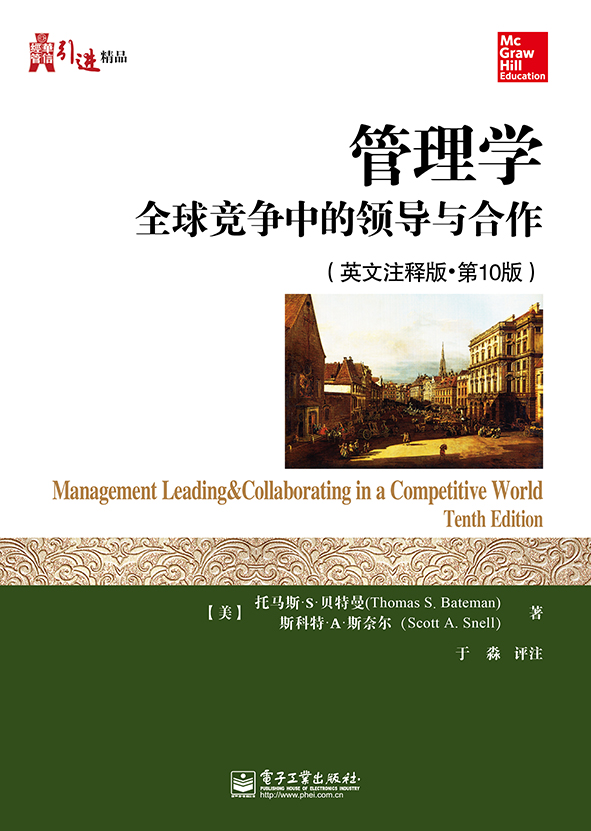管理学:全球竞争中的领导与合作(英文注释版·第10版)
作 译 者:于淼等
出 版 日 期:2014-11-01
出 版 社:电子工业出版社
维 护 人:
书 代 号:G0240290
I S B N:9787121240294
图书简介:
本书既按照管理学的基本理论框架——计划、组织、领导和控制,又紧紧围绕竞争优势的五个重要因素——成本、质量、速度、创新和服务进行介绍。全书内容丰富实用,既全面介绍了管理学的基本内容,又与创新的理论进展和管理实践密切相关;实践性和时代感强,收录了许多管理案例和实践方法。既能帮助老师有效地组织教学,又能使学生或职业经理人学习到最新的理论和实践方法。
定价 69.0
您的专属联系人更多

联系人:王二华
电话:010-88254532
邮箱:wangrh@phei.com.cn
-
配 套 资 源图书特别说明:
本书资源
本书暂无资源会员上传本书资源
-
图 书 内 容
内容简介
本书既按照管理学的基本理论框架——计划、组织、领导和控制,又紧紧围绕竞争优势的五个重要因素——成本、质量、速度、创新和服务进行介绍。全书内容丰富实用,既全面介绍了管理学的基本内容,又与创新的理论进展和管理实践密切相关;实践性和时代感强,收录了许多管理案例和实践方法。既能帮助老师有效地组织教学,又能使学生或职业经理人学习到最新的理论和实践方法。图书详情
ISBN:9787121240294开 本:16开页 数:548字 数:1140本书目录
Contents PART ONE Foundations of Management(管理学基本原理) Chapter 1 Managing and Performing(管理和执行) 2 1.1 Managing in the New Competitive Landscape 3 1.2 Managing for Competitive Advantage 7 1.3 The Functions of Management 12 1.4 Management Levels and Skills 16 1.5 You and Your Career 20 Key Terms 26 Summary Of Learning Objectives 26 Discussion Questions 27 Chapter 2 The External and Internal Environments(内外部环境) 28 2.1 The Macroenvironment 30 2.2 The Competitive Environment 36 2.3 Environmental Analysis 45 2.4 Responding to the Environment 48 2.5 The Internal Environment of Organizations: Culture and Climate 53 Key Terms 59 Summary Of Learning Objectives 59 Discussion Questions 60 Chapter 3 Managerial Decision Making(管理决策的制定) 62 3.1 Characteristics of Managerial Decisions 63 3.2 The Stages of Decision Making 66 3.3 The Best Decision 73 3.4 Barriers to Effective Decision Making 73 3.5 Decision Making in Groups 77 3.6 Managing Group Decision Making 78 3.7 Organizational Decision Making 82 Key Terms 86 Summary Of Learning Objectives 86 Discussion Questions 87 PART TWO Planning: Delivering Strategic Value(计划:制定战略价值) Chapter 4 Planning and Strategic Management(计划与战略管理) 90 4.1 An Overview of Planning Fundamentals 91 4.2 Levels of Planning 96 4.3 Strategic Planning 101 Key Terms 117 Summary Of Learning Objectives 118 Discussion Questions 119 Chapter 5 Ethics and Corporate Responsibility(道德与企业责任) 120 5.1 Ethics 123 5.2 Corporate Social Responsibility 134 5.3 The Natural Environment and Sustainability 139 Key Terms 143 Summary Of Learning Objectives 144 Discussion Questions 145 Chapter 6 International Management(管理国际化) 146 6.1 Managing in a (Sometimes) Flat World 147 6.2 The Global Environment 154 6.3 Global Strategy 160 6.4 Entry Mode 168 6.5 Managing across Borders 171 Key Terms 180 Summary Of Learning Objectives 180 Discussion Questions 181 Chapter 7 Entrepreneurship(创业型企业) 182 7.1 Entrepreneurship 186 7.2 Corporate Entrepreneurship 205 Key Terms 208 Summary Of Learning Objectives 208 Discussion Questions 209 PART THREE Organizing: Building A Dynamic Organization(组织:建立动态组织) Chapter 8 Organization Structure(组织结构) 212 8.1 Fundamentals of Organizing 213 8.2 The Vertical Structure 215 8.3 The Horizontal Structure 222 8.4 Organizational Integration 233 8.5 Looking Ahead 237 Key terms 238 Summary Of Learning Objectives 238 Discussion Questions 239 Chapter 9 Organizational Agility(组织敏捷性) 241 9.1 The Responsive Organization 242 9.2 Strategy and Organizational Agility 244 9.3 Organizational Size and Agility 248 9.4 Customers and the Responsive Organization 253 9.5 Technology and Organizational Agility 260 9.6 Final Thoughts on Organizational Agility 267 Key Terms 268 Summary Of Learning Objectives 269 Discussion Questions 269 Chapter 10 Human Resources Management(人力资源管理) 271 10.1 Strategic Human Resources Management 272 10.2 Staffing the Organization 277 10.3 Developing the Workforce 288 10.4 Performance Appraisal 290 10.5 Designing Reward Systems 295 10.6 Labor Relations 301 Key Terms 305 Summary Of Learning Objectives 305 Discussion Questions 306 Chapter 11 Managing the Diverse Workforce(人力管理多样化) 308 11.1 Diversity: A Brief History 310 11.2 Diversity Today 311 11.3 Managing Diversity versus Affirmative Action 321 11.4 Multicultural Organizations 327 11.5 How Organizations Can Cultivate a Diverse Workforce 330 Key Terms 337 Summary Of Learning Objectives 337 Discussion Questions 338 PART FOUR Leading: Mobilizing People(领导:激励员工) Chapter 12 Leadership(领导) 340 12.1 What Do We Want from Our Leaders? 341 12.2 Vision 342 12.3 Leading and Managing 344 12.4 Power and Leadership 346 12.5 Traditional Approaches to Understanding Leadership 348 12.6 Contemporary Perspectives on Leadership 359 12.7 Developing Your Leadership Skills 364 Key Terms 366 Summary Of Learning Objectives 367 Discussion Questions 368 Chapter 13 Motivating for Performance(绩效激励) 369 13.1 Motivating for Performance 370 13.2 Setting Goals 371 13.3 Reinforcing Performance 373 13.4 Performance-Related Beliefs 378 13.5 Understanding People’s Needs 380 13.6 Designing Motivating Jobs 383 13.7 Achieving Fairness 388 13.8 Job Satisfaction 391 Key Terms 395 Summary Of Learning Objectives 395 Discussion Questions 396 Chapter 14 Teamwork(团队工作) 397 14.1 The Contributions of Teams 398 14.2 The New Team Environment 399 14.3 How Groups Become Real Teams 401 14.4 Building Effective Teams 404 14.5 Managing Lateral Relationships 411 Key Terms 418 Summary Of Learning Objectives 418 Discussion Questions 419 Chapter 15 Communicating(沟通) 420 15.1 Interpersonal Communication 421 15.2 Improving Communication Skills 430 15.3 Organizational Communication 437 Key Terms 445 Summary Of Learning Objectives 445 Discussion Questions 446 PART FIVE Controlling: Learning and Changing(控制:学习与变革) Chapter 16 Managerial Control(管理控制) 448 16.1 Bureaucratic Control Systems 451 16.2 The Other Controls: Markets and Clans 472 Key Terms 478 Summary Of Learning Objectives 478 Discussion Questions 479 Chapter 17 Managing Technology and Innovation(管理技术与创新) 480 17.1 Technology and Innovation 481 17.2 Technological Innovation in a Competitive Environment 485 17.3 Assessing Technology Needs 489 17.4 Key Factors to Consider in Technology Decisions 490 17.5 Sourcing and Acquiring New Technologies 497 17.6 Technology and Managerial Roles 500 17.7 Organizing for Innovation 501 Key Terms 506 Summary Of Learning Objectives 506 Discussion Questions 507 Chapter 18 Creating and Leading Change(创造和管理变革) 509 18.1 Becoming World Class 510 18.2 Managing Change 514 18.3 Shaping the Future 525 Key Terms 533 Summary Of Learning Objectives 533 Discussion Questions 533展开前 言
评 注 说 明 接到托马斯·S·贝特曼教授和斯科特·A·斯奈尔教授《管理学:全球竞争中的领导与合作》这本书的注释版的评注工作之后,我仔细地多次通读了该书的原著。在阅读学习的同时,我也一直在思考这样一个问题:究竟哪些内容最应该作为本书的精华体现在这个注释版本中呢?是本书的独特观点、学习难点、生动的案例,还是这个版本中较为前沿而深刻的理论呢?应该说都是,又都不是。经过反复的思考,我的决定是按照书中的核心主线,在能充分诠释管理学运行机理的前提下,将书中与时代脉搏契合最紧密的点用一条线连接起来呈现给读者。这样,既能对原著起到拾遗补缺、画龙点睛的作用,也能让读者在最短时间里掌握这本佳作的核心精华。 自迈克尔波特的《竞争战略》问世以来,在全球化和供应链管理主导的今天,企业核心竞争力的培养和维系已经成为当今管理者工作的重中之重。本书抓住这个核心的关节点,通过五大部分从管理学几大职能的不同角度充分诠释了这一思想。具体的内容格局如下:第一部分阐述了管理的基本职能、角色和性质,并提出了成本竞争力、质量、速度和创新这四个新的关注点;第二部分从计划的职能出发,对组织内外部环境进行介绍与归纳,并提出如何在适应环境的同时,合理地改变环境这一论题;第三部分以组织职能为重点,强调在建立动态组织的同时,提高组织灵活性;第四部分则从员工角度入手,督促管理者遵循管理的激励职能用以加强团队的管理与沟通;第五部分则是要提醒管理者对控制职能的重视,以前瞻性来关注技术创新与组织变革。其中最为重要的就是发展企业的核心竞争能力。 为了能让读者更系统地学习到企业竞争力的重要性、形成过程和运用方法,以及如何领导并整合企业竞争优势,贝特曼教授及他的工作团队将上述要点分解并嵌入到本书的18个章节中,并结合最新的、最具典型性的案例为读者娓娓道来。同时,第10版的案例结构也不再像此前诸版中以欧美国家为主,而是将重心转向了印度、中国这样的发展中国家。相信读者在学习本书的过程中可以更加熟悉地融入情景,也能更好地体会案例中所要传达的知识精髓。 本书为原书的注释版,经全面分析原书重点和难点后加入了忠于原文的中文注解。此外,还特别在每个章节加入了章前导读模块,希望通过简短的章前语能让读者快速把握本章所要传达的知识点。另外,本书还附有与讲授内容配套的延伸阅读、案例材料以及习题,需要者可自华信教育资源网(http://www.hxedu.com.cn/)注册之后免费下载。 本书的具体注释分工如下: 于淼教授负责统校、撰写译者前言及第9~12章的注释; 肖冀秋负责第5~8章的注释; 王妍负责第1~4章的注释; 束艳杰负责第13~16章的注释; 陈朝负责第17~18章的注释; 此外,我在这里还要特别感谢电子工业出版社石会敏主任及其工作团队在工作过程中给予的宝贵建议和热情帮助,以及在整个出版工作中付出的艰苦努力。 最后,由于注释者水平有限,书中难免存在疏漏和对原著的理解不足之处,敬请各位读者在阅读过程中提出宝贵意见。 于 淼 中国政法大学商学院教授 2014年8月20日于北京 Preface Welcome to our 10th edition! Thank you to everyone who has used and learned from previous editions and helped make this book such a success. We are proud to present the newest edition. With the many challenges that we all face, this is truly an exciting time in business. Technology, innovation, and global commerce are transforming industries. Companies like Facebook, Whole Foods, NetFlix, and others are revolutionizing not only their industries but also the way we live our lives. The fact that they are unseating their more traditional rivals shows that entrepreneurs and courageous leaders can have a significant impact on business and on the world. Whether it’s driving creativity and innovation (Google), continuously improving quality (Mayo Clinic), or relentlessly pursuing productivity and cost (Southwest), managers are uniquely positioned to work with their people to achieve competitive advantage in business and to make a difference in the world. But succeeding in a challenging work world is not just about competing; collaborating with others is more essential than ever, too. Joint ventures and strategic alliances such as Apple’s partnership with Rovio (maker of Angry Birds) show just how important it is that people within and between different organizations—even rivals—work together effectively. This collaboration is more global than ever. Countries like India and China are center stage not just because of the rapid growth and sheer size of their economies and consumer markets, but because of the productive power of their people and the growing capability of their companies. As things change in business and in the world more broadly, the metaphorical glass sometimes seems half-empty. Unfortunate world events, disconcerting trends, and ineffective and unethical management practices will continue. But good people will continue to step up and take on important leadership roles, managing well and making things better, as they always have. In this book you will read about many managers, some doing things brilliantly, others making mistakes (with some learning from their mistakes, and some not). Some organizations rise from the ashes, or come from seemingly nowhere, to become the next hot investment. Some organizations are high-flyers one day and come crashing down the next. Some achieve greatness, and have occasional downturns, but continue being great. These performance shifts occur in large part due to the ways in which they are managed, and partly from how circumstances change. Business environments, like pendulums, swing from one extreme to another. These changes will contribute to the fall of some currently successful companies and managers and the rise of others who currently struggle or are now just dreaming of new business ideas. For you, as a businessperson as in life, uncertainty will be a constant state of affairs. That is, no one knows for certain what will happen, or what to do in pursuit of a successful future. Luck and the right circumstances can help companies (and people) succeed in the short run. But in the long run good management is essential. Fortunately, you have access to current knowledge about how to manage. We have learned a lot from the companies that have succeeded and failed. The continuing experiment created by the vast array of management practices that exist in the business world, combined with sound research that helps tease out what works from what doesn’t, helps us learn from mistakes and identify the most important lessons and useful practices that managers can employ. We hope that you will not only learn as much as you can about this vital activity but also commit to applying it—by reading and learning, and by using it in the best possible ways. This book and the course you are taking will help you face the managerial challenges of a changing world. In doing so, they will help you identify what’s important and what’s not, make good decisions, and take effective action on behalf of yourself, your colleagues, and the organizations for which you work. Our Goals Our mission with this text hasn’t changed from that of our previous editions: to inform, instruct, and inspire. We hope to inform by providing descriptions of the important concepts and practices of modern management. We hope to instruct by describing how you can take action on the ideas discussed. We hope to inspire not only by writing in a positive, interesting, and optimistic way but also by providing a real sense of the opportunities ahead of you. Whether your goal is starting your own company, leading a team to greatness, building a strong organization, delighting your customers, or generally forging a positive future, we want to inspire you to take positive actions. We hope to inspire you to be both a thinker and a doer. We want you to think about the issues, think about the impact of your actions, think before you act. But being a good thinker is not enough; you also must be a doer. Management is a world of action. It is a world that requires timely and appropriate action. It is a world not for the passive but for those who commit to positive accomplishments. Keep applying the ideas you learn in this course, read about management in sources outside of this course, and keep learning about management after you leave school and continue your career. Make no mistake about it: learning about management is a personal voyage that will last years, an entire career, your entire lifetime. Competitive Advantage Today’s world is competitive. Never before has the world of work been so challenging. Never before has it been so imperative to your career that you learn the skills of management. Never before have people had so many opportunities and challenges with so many potential risks and rewards. You will compete with other people for jobs, resources, and promotions. Your organization will compete with other firms for contracts, clients, and customers. To survive the competition, and to thrive, you must perform in ways that give you an edge over your competitors, that make the other party want to hire you, buy from you, and do repeat business with you. You will want them to choose you, not your competitor. To survive and thrive, today’s managers have to think and act strategically. Today’s customers are well educated, aware of their options, and demanding of excellence. For this reason, managers today must think constantly about how to build a capable workforce and manage in a way that delivers the goods and services that provide the best possible value to the customer. By this standard, managers and organizations must perform. Six essential types of performance, on which the organization beats, equals, or loses to the competition, are cost, quality, speed, innovation, service and sustainability. These six performance dimensions, when managed well, deliver value to the customer and competitive advantage to you and your organization. We will elaborate on all of these topics throughout the book. The idea is to keep you focused on a type of “bottom line,” to make sure you think continually about “delivering the goods” that make both you and your organization a competitive success. This results-oriented approach is unique among management textbooks. Leading & Collaborating Yes, business is competitive. But it’s not that simple. In fact, to think strictly in terms of competition is overly cynical, and such cynicism can sabotage your performance. The other fundamental elements in the success equation are collaboration and leadership. People working with, rather than against, one another are essential to competitive advantage. Put another way, you can’t do it alone—the world is too complex, and business is too challenging. You need to work with your teammates. Leaders and followers need to work as collaborators more than as adversaries. Work groups throughout your organization need to cooperate with one another. Business and government, often viewed as antagonists, can work productively together. And today more than ever, companies that traditionally were competitors engage in joint ventures and find other ways to collaborate on some things even as they compete in others. Leadership is needed to make these collaborations happen. How does an organization create competitive advantage through collaboration? It’s all about the people, and it derives from good leadership. Three stereotypes of leadership are that it comes from the top of the company, that it comes from one’s immediate boss, and that it means being decisive and issuing commands. These stereotypes may contain grains of truth, but the reality is much more complex. First, the person at the top may or may not provide effective leadership—in fact, many observers believe that good leadership is far too rare. Second, organizations need leaders at all levels, in every team and work unit. This includes you, beginning early in your career, and this is why leadership is an important theme in this book. Third, leaders should be capable of decisiveness and of giving commands, but relying too much on this traditional approach isn’t enough. Great leadership is far more inspirational than this, and helps people both to think differently and also to work differently—including working collaboratively with a focus on results. Leadership—from your boss as well as from you—generates collaboration, which in turn creates results that are good for the company and good for the people involved. As Always, Currency and Variety in the 10th Edition It goes without saying that this textbook, in its 10th edition, remains on the cutting edge of topical coverage, as updated via both current business examples and recent management research. Chapters have been thoroughly updated, and students are exposed to a broad array of important current topics. We have done our very best to draw from a wide variety of subject matter, sources, and personal experiences. We continue to emphasize throughout the book themes such as real results, ethics, cultural considerations, and leadership and collaboration. Here is just a small sampling of new highlights in the 10th edition—enough to convey the wide variety of people, organizations, issues, and contexts represented throughout the text. Chapter 1 A new title for this chapter, “Managing and Performing.” The Management Connection discusses how Tesla Motors managers keep the company productive. New examples include ReCellular, Dunkin’ Brands Culinary Innovation Team, Singapore Airlines, Aetna, and basic practices of good management at textile factories in India. A new section on sustainability has been added to the chapter. Chapter 2 A new title for this chapter, “The External and Internal Environments.” The Management Connection examines how Apple concentrates on being a winner in a fast-changing environment. Information on the Affordable Care Act of 2010 discusses the legal provisions aimed at health care. A new section on the natural environment. New examples include Tata Motors and breaks in supplier chains caused by the external environment. New Table 2.1. Chapter 3 A new Management Connection on Pandora Media, one of the world’s most innovative companies according to Fast Company magazine. New examples include Capterra, Chargify, and Integrated Medical Solutions. Updated graphics on organizations’ strategy decisions. BP’s Deepwater Horizon disaster is used as an example to discuss management decision making. Chapter 4 A new Management Connection on General E lectric. New examples include General Motors, Price Chopper Supermarkets, an Iraqi commercial sign store, AXA Canada, and Cisco Systems. A discussion of the trends shaping how companies grow. Chapter 5 The Management Connection looks at corporate social responsibility at Patagonia. New examples include overbooked hotel practices, Hilton Worldwide call centers, Countrywide Financial, and 3M. Updated graphics on ethics. Chapter 6 The Management Connection discusses IKEA’s global presence and sustainability. The need for employees and sales from other countries outside the United States to meet their objectives. New Table 6.1. India’s growing role in the global marketplace. New examples include Stanbic IBTC Bank in-Nigeria, Master Lock, and Ignighter.com. A new Figure 6.3 on the top 10 global firms. Chapter 7 A new Management Connection about Chip- otle’s founder, Steve Ells. New examples include inDinero, research on entrepreneurs, Toepener, CopyShark.net, and the Unreasonable Institute. A new section on social entrepreneurship. Updated graphics on money management. Chapter 8 The Management Connection discusses the organization chart at Cisco Systems. New examples include Harmonix Music Systems, Valve Software, Walt Disney Studios, and Love Machine. Updated graphics on delegating leadership responsibilities. New Tables 8.1 and 8.2. Chapter 9 A new Management Connection on how Pixar thrives in a changing industry. A discussion of ambidextrous organizations. New examples include Pfizer, Salesforce.com, and Miles Chemical. A new key term definition of six sigma quality. Chapter 10 The Management Connection looks at Google’s ability to hire great employees. New examples include GM’s Chevy Volt, Walmart, and Sprint. Updated section on drug testing. New Figure 10.4. Chapter 11 A new Management Connection on PepsiCo. New examples include CH2M Hill, Procter & Gamble, and Ernst & Young. New Tables 11.1, 11.2, 11.4, and 11.5. Updated graphics on employee resource groups. A discussion of leveraging difference. Chapter 12 The Management Connection looks at Howard Schultz and Starbucks. New examples include George Buckley of 3M, Linda Parker Hudson of General Dynamics, and Kathy Savitt of Lockerz. Chapter 13 A new Management Connection about Intuit being a great place to work. Updated graphics on employee engagement. New examples include Quick Lane Tire & Auto Center, Rable Machine, and K Hotels Sales & Marketing. Chapter 14 The Management Connection discusses teamwork at Toyota. New examples include Wells’s Dairy and IBM. Updated graphics on how senior managers spend their time. Chapter 15 A new Management Connection on Zinger- man’s Delicatessen. Updated graphics on the variety of com- munication methods. New examples include SlideShare, Hilcorp Energy Company, Applied Materials, and Royal Caribbean Cruises. Chapter 16 The Management Connection examines controls at Southwest Airlines. New examples include Hertz, Family Practice Association, and Netflix. Updated graphics on quality control. Chapter 17 A new Management Connection on BP’s alternative energy future. Discussion of innovation and its three fundamental types. New examples include Pratt & Whitney, Facebook, and the military’s use of solar technology. The limits organizations have put on in- formation technology at work. New Figure 17.5. Chapter 18 The Management Connection discusses Dr. Peter Pronovost. New examples include Goodrich Aerostruc- tures and Jacqueline Woods. Updated graphics on the length of time people spend with the same employer. A Team Effort This book is the product of a fantastic McGraw-Hill/Irwin team. Moreover, we wrote this book believing that we are part of a team with the course instructor and with students. The entire team is responsible for the learning process. Our goal, and that of your instructor, is to create a positive learning environment in which you can excel. But in the end, the raw material of this course is just words. It is up to you to use them as a basis for further thinking, deep learning, and constructive action. What you do with the things you learn from this course, and with the opportunities the future holds, counts. As a manager, you can make a dramatic difference for yourself and for other people. What managers do matters, tremendously.展开作者简介
本书暂无作者简介 -
样 章 试 读本书暂无样章试读!
-
图 书 评 价 我要评论








